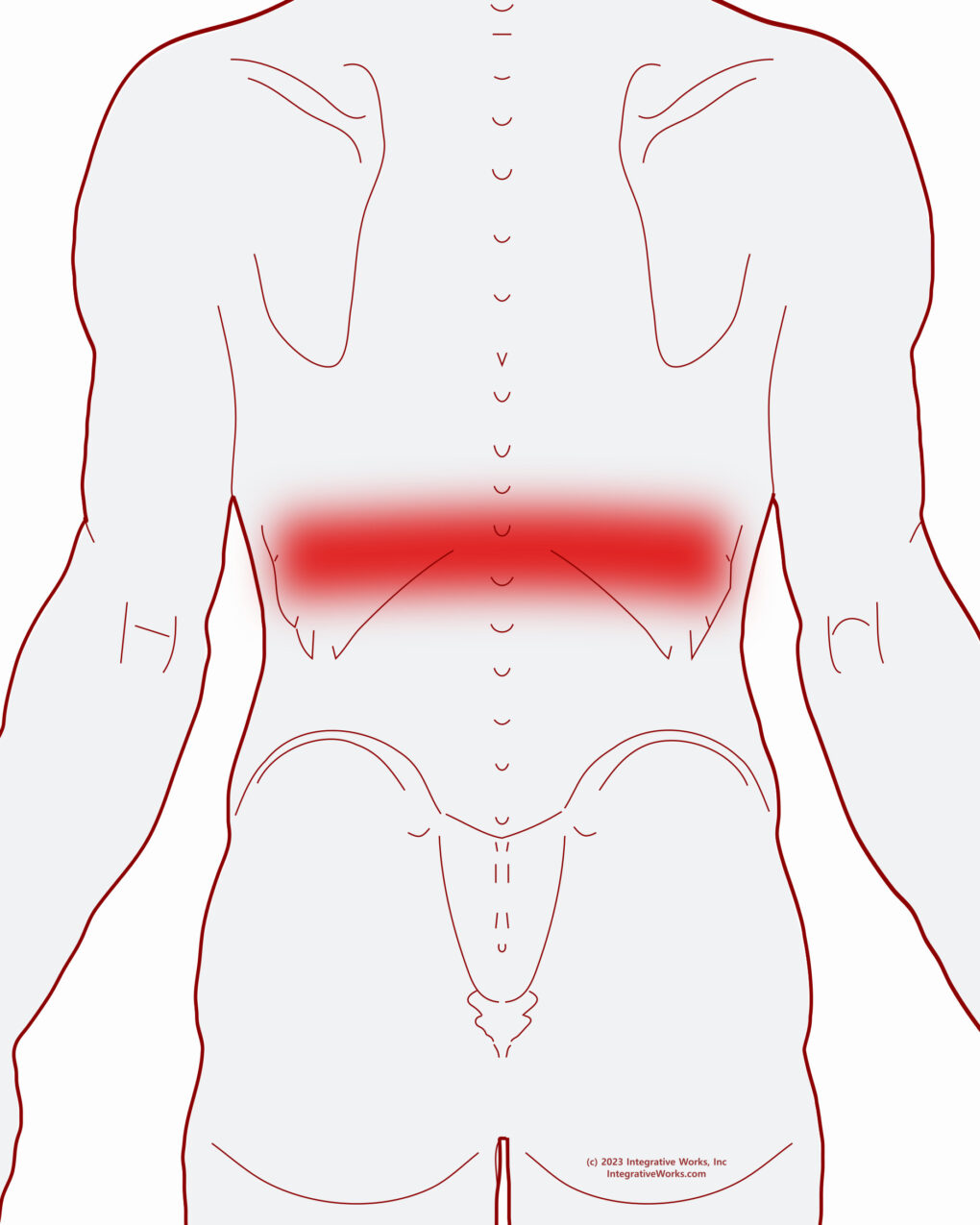Band of Pain Across the Mid-back
Table of Contents
- How People Describe This Pain Pattern
- How You Activate and Intensify This Pain Pattern
- Self-Care – Getting Relief on Your Own
- Musculoskeletal Anatomy Behind Your Pain
- Therapy Notes for Massage and Bodywork
How People Describe This Pain Pattern


Pain Across Ribs
These people complain of a broad band of pain across the mid back. So they reach back and trace a band across their mid-back.
At this point, I have them stroke an ice cube over the arch of the ribs in the front. They usually have a look of disbelief but comply. Then, I have them lay back on the table, stretching their abdomen open and letting it close a few times. This could also be released with the yoga poses described in self-care. Again, they seem surprised when the pain is dramatically reduced or completely gone.
See Your Doctor
This pain across the mid-back is similar to some sensations created by some internal organs, Especially when it is stronger on one side. Notably, chronic kidney disease may produce a similar pattern.
How You Activate and Intensify This Pain Pattern
Change in Exercise
This pattern is usually initiated by some activity that overworks the abdomen. For instance, activities such as crunches, coitus, and kicking a soccer ball. Usually, this is an unusual change in activity.
This trigger point occurs in the upper abdomen. So, the activity usually involves more upper body movement to crunch than the hips. Additionally, the abdominals compress the abdomen during forceful exhalation. Consequently, this can be further aggravated by labored breathing.
Sudden twist
Also, this pain across the mid-back happens more easily to people with extra weight around their midsection. A moderate change in activity or a sudden twisting movement can activate this trigger point. Unfortunately, a moderate jerking movement, like almost falling, can cause this.
The Musculoskeletal Anatomy Behind Your Pain
Musculoskeletal Anatomy
This post on anatomy contains standard information about the origin, insertion, function, and innervation of muscles. Additionally, it includes information on functional considerations and anomalies.
Find Related Posts
Anatomy posts have a grid of all related posts. This includes posts on pain patterns, self-care, therapy notes, NMT protocols, cranial techniques, and cases.
Getting Relief on Your Own
Clinically Proven
Self-Care Strategies
Self-Care Posts have common sections to make them easy to follow and understand:
- Activities to Avoid or Change
- Strategies for Quick Relief
- Stretches and Exercise for Longer-Lasting Relief
- Yoga Corner
Therapy Notes for Massage and Bodywork
Better Bodywork
Through Shared Expertise
Therapy Notes provide details for cranial, spinal, and local joint work. These notes also link to a traditional neuromuscular protocol.
By treating integrative components first, direct work on the muscle becomes less intense while providing longer-lasting relief.
You will get temporary relief from treating the muscle directly. It does not release the underlying problems in the pelvis. See your bodyworker for lasting relief.
Support Integrative Works to
stay independent
and produce great content.
You can subscribe to our community on Patreon. You will get links to free content and access to exclusive content not seen on this site. In addition, we will be posting anatomy illustrations, treatment notes, and sections from our manuals not found on this site. Thank you so much for being so supportive.
Cranio Cradle Cup
This mug has classic, colorful illustrations of the craniosacral system and vault hold #3. It makes a great gift and conversation piece.
Tony Preston has a practice in Atlanta, Georgia, where he sees clients. He has written materials and instructed classes since the mid-90s. This includes anatomy, trigger points, cranial, and neuromuscular.
Question? Comment? Typo?
integrativeworks@gmail.com
Follow us on Instagram
*This site is undergoing significant changes. We are reformatting and expanding the posts to make them easier to read. The result will also be more accessible and include more patterns with better self-care. Meanwhile, there may be formatting, content presentation, and readability inconsistencies. Until we get older posts updated, please excuse our mess.